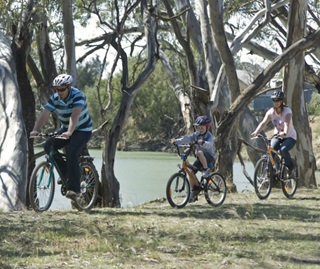Policy first adopted 1 April 2007
Policy last updated July 2022
Scope and application
This policy applies to all lands acquired or reserved under the National Parks and Wildlife Act 1974 (NPW Act) except for lands reserved under Part 4A of the Act (unless the Board of Management for those lands has adopted the policy). However, NPWS staff can use the policy as guidance when working with Boards of Management and on Part 4A lands.
This policy applies to roads that are reserved as part of a NPWS park or reserve. NPWS parks and reserves are often traversed by public roads (i.e. not part of the park); cycling access on these roads is outside the scope of this policy.
Objectives
This policy guides the provision of cycling opportunities in national parks and reserves, consistent with the objects and management principles in the National Parks and Wildlife Act 1974.
Definitions
Adaptive bicycle/mountain bike refers to a range of bicycles such as hand cycles, knee cycles, tandem cycles, tricycles, quadricycles or other modified bicycles to suit a person's physical, intellectual, neurological and sensory abilities.
Bicycle means any pedal powered vehicle with wheels, including road bicycles, tricycles, power-assisted pedal cycle/e-bikes/pedelecs, adaptive bicycles and mountain bikes.
Cycling means riding a bicycle (see above definition) in any style. Cycling does not include the riding of motorised bicycles other than those defined as power-assisted pedal cycles.
E-bike means power-assisted pedal cycle.
Management trails are vehicle trails on lands reserved or acquired under the NPW Act and which are maintained by NPWS for the purpose of park management activities. They are generally not open to public motor vehicle access (see Vehicle Access Policy).
Off-track means cycling through the landscape of a park or reserve away from formed roads, management trails or tracks.
Park means a reserve gazetted under the NPW Act, including a national park, nature reserve, historic site, Aboriginal area, state conservation area, karst conservation reserve, or regional park, or any land acquired by the Minister under Part 11 of the Act. It includes a park managed jointly with the Aboriginal community under Part 4A of the Act.
Park road means a road reserved as part of a park or reserve that is open to the public, although they can be closed for park management reasons. They are maintained by NPWS.
Plan of Management means an adopted plan of management for a park.
Power-assisted pedal cycle is a form of bicycle defined by the NSW Road Rules in accordance with Commonwealth law (Vehicle Standard [Australian Design Rule – Definitions and Vehicle Categories] 2005 and Motor Vehicle Standards Act 1989). It is currently defined as:
- designed to be propelled primarily by human power that has one or more auxiliary (electric) propulsion motors attached to assist the rider, but cannot be propelled exclusively by the motors
- having a combined power output not exceeding 200 watts, or a maximum continued rated power of 250 watts of which the output cuts off when the cycles reaches 25 kilometres per hour or the cyclist stops pedalling
- weighs less than 35 kilograms.
This type of bicycle may also be referred to as an electrically power-assisted cycle, pedelec or e-bike. This definition does not include any form of vehicle that has an internal combustion engine.
Pedelec means power-assisted pedal cycle.
Road is defined in the roads legislation and means an area that is open to or used by the public and is developed for, or has as one of its main uses, the driving or riding of motor vehicles (see Vehicle Access Policy).
Track means an access way that is not open to motorised vehicles (other than motorised wheelchairs and other mobility devices):
- Single-use track means a track designated for use by only one form of activity. In this policy, the term is used to describe cycling-only tracks
- Multi-use track means a track designated for shared use by multiple forms of activity. In some instances, multi-use tracks may be limited to just 2 uses, such as cycling and walking
- Preferred-use tracks means a type of multi-use track that is designed primarily for cycling, but which other users are not excluded from using.
- Unauthorised track means a track that has not been approved by the NPWS for construction and/or use as a cycling track in accordance with this policy, a plan of management, the NPW Act or NPW Regulation.
Accountabilities
This section outlines NPWS staff with significant responsibilities for ensuring the implementation of the policy.
| Paragraph |
Position |
| 4. Approval of off-track cycling |
Area Manager |
| 22. Minor adjustments to cycling access |
Director or Area Manager (depending on level of environmental assessment required) |
 Cycling, including mountain biking, is a popular and healthy recreational activity that can raise awareness, appreciation and understanding of the natural environment.
Cycling, including mountain biking, is a popular and healthy recreational activity that can raise awareness, appreciation and understanding of the natural environment. 




